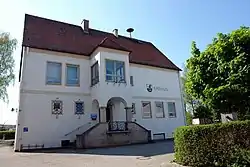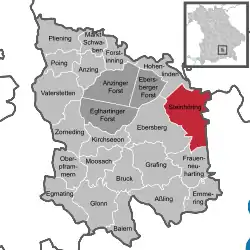Steinhöring
Steinhöring is a community in the Upper Bavarian district of Ebersberg.
Steinhöring | |
|---|---|
 Town hall | |
 Coat of arms | |
Location of Steinhöring within Ebersberg district  | |
 Steinhöring  Steinhöring | |
| Coordinates: 48°5′N 12°2′E | |
| Country | Germany |
| State | Bavaria |
| Admin. region | Oberbayern |
| District | Ebersberg |
| Government | |
| • Mayor | Martina Lietsch (FLS) |
| Area | |
| • Total | 36.29 km2 (14.01 sq mi) |
| Elevation | 519 m (1,703 ft) |
| Population (2019-12-31)[1] | |
| • Total | 4,124 |
| • Density | 110/km2 (290/sq mi) |
| Time zone | UTC+01:00 (CET) |
| • Summer (DST) | UTC+02:00 (CEST) |
| Postal codes | 85643 |
| Dialling codes | 08094 |
| Vehicle registration | EBE |
| Website | www.gemeinde-steinhoering.de |
Geography
Steinhöring lies in the Munich Region. It lies in the south-east of the Ebersberger Forst (forest) which is one of the largest continuous area of woodlands in Germany.
It includes two traditional rural land units (Gemarkungen in German) named Sankt Christoph and Steinhöring.
Neighbouring communities are Ebersberg, Hohenlinden and Frauenneuharting.
Subdivisions
Steinhöring is divided into many boroughs:
Sankt Christoph and Tulling; Abersdorf, Berg, Endorf, Hintsberg, Schützen und Sensau; the hamlets Aschau, Au, Dichtlmühle, Dietmering, Elchering, Etzenberg, Graben, Höhenberg, Holzhäusln, Kraiß, Niederaltmannsberg, Oberseifsieden, Ötzmann, Rupertsdorf, Schechen, Sprinzenöd, Unterseifsieden, Wall, Welling, Winkl and Zaißing as well as the housing-groups of Blöckl, Buchschechen, Helletsgaden, Hofstett, Hub, Lehen, Lieging, Mayrhof, Meiletskirchen, Neuhardsberg, Oed, Oelmühle, Ranhartsberg, Salzburg, Schätzl, Schweig, Stinau, Thailing, Untermeierhof and Winkl b. Sankt Christoph.
History
The community’s first documentary mention was in 824. By the 16th century, Steinhöring boasted a regionally important postal station. It belonged to the Rentamt of Munich and the Court of Swabia of the Electorate of Bavaria and was the seat of a captaincy (Hauptmannschaft).
In 1936, the Nazi racial organization Lebensborn’s first “Mother-Child-Home” (Mutter-Kind-Heim) was opened in Steinhöring.
In the course of administrative reforms in Bavaria, the current community came into being with the community edict in 1818. In 1972, the former community of St. Christoph was amalgamated with Steinhöring.
Population development
The community’s land area was home to 2,395 inhabitants in 1970, 3,068 in 1987 and 3,540 in 2000.
Politics
The mayor (Bürgermeister) is Martina Lietsch (FLS). The municipal council consists of 16 politicians.
The community’s tax revenue for 2010 was €2,545,000, of which €392,000 was business taxes.
Coat of arms
Steinhöring’s arms might heraldically be described thus: Party per fess, above in argent a half ibex rampant sable, below in azure a horizontal postal horn argent.
Economy and infrastructure
According to official statistics from 2010, 18 contributors to the social welfare rolls were employed in agriculture and forestry, whereas in industry the figure was 274. In trade and transport it was 122, and in other fields 488. Contributors working from home numbered 1,445. Furthermore, there are 75 businesses in agriculture with a total productive area of 1884 ha, of which 818 ha was cropland and 1 085 ha was meadowland.
Education
In 2010, the following institutions existed in Steinhöring:
- Kindergartens: 3 Kindergartens with, 1 of them integrates also handicapped children and works on basis of Montessori pedagogics
- Elementary school
- School for handicapped children[2]
References
- "Tabellenblatt "Daten 2", Statistischer Bericht A1200C 202041 Einwohnerzahlen der Gemeinden, Kreise und Regierungsbezirke". Bayerisches Landesamt für Statistik und Datenverarbeitung (in German). July 2020.
- Korbinianschule Steinhöring